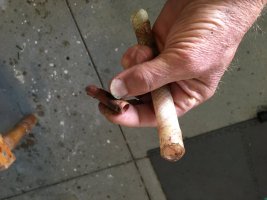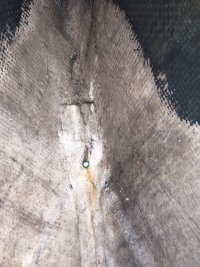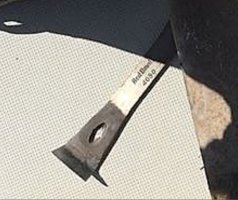My anchor locker drain hose failed offshore. The stub installed in the stem was a short length of 1/2" copper tubing, which corroded in salt water after 37 years of service.
I yanked the pan this week, which required only a few hours patience with pry bars and caulk softener, and will install a new stub and hose.
I wonder why the factory used copper. Perhaps for its antifouling character? Copper seems wrong for salt water.
Even so, I'll probably install a new copper stub for the hose to mate to. Another 37 years seems acceptable.
The hose is worth checking, since a detached hose will sink the boat if nobody is paying attention. Water only comes in when bashing into head seas, but it comes in fast. Visual inspection is not reliable for this inaccessible part. My new rule is: "you haven't inspected a fitting unless you have touched it," which in the case of the drain hose on the E38 is not possible to do.
 ...
... ...
...
I yanked the pan this week, which required only a few hours patience with pry bars and caulk softener, and will install a new stub and hose.
I wonder why the factory used copper. Perhaps for its antifouling character? Copper seems wrong for salt water.
Even so, I'll probably install a new copper stub for the hose to mate to. Another 37 years seems acceptable.
The hose is worth checking, since a detached hose will sink the boat if nobody is paying attention. Water only comes in when bashing into head seas, but it comes in fast. Visual inspection is not reliable for this inaccessible part. My new rule is: "you haven't inspected a fitting unless you have touched it," which in the case of the drain hose on the E38 is not possible to do.
 ...
... ...
...

